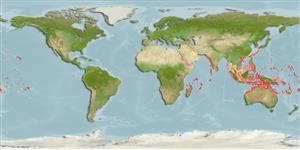Common names from other countries
Environment: milieu / climate zone / depth range / distribution range
Sinh thái học
Biển Cùng sống ở rạn san hô; Mức độ sâu 30 - 50 m (Ref. 1602). Tropical; 32°N - 24°S, 30°E - 145°W
Indo-Pacific: Red Sea to East Africa, through northern Australia to Society Islands, north to southern Japan.
Bộ gần gũi / Khối lượng (Trọng lượng) / Age
Maturity: Lm ? range ? - ? cm
Max length : 55.0 cm TL con đực/không giới tính; (Ref. 9770)
Các tia vây lưng cứng (tổng cộng) : 3; Các vây lưng mềm (tổng cộng) : 24 - 27; Tia cứng vây hậu môn: 0; Tia mềm vây hậu môn: 19 - 24. Dark brown, scales with yellow spot; pectoral, soft dorsal, anal and caudal fins dark with yellow margins; juveniles yellowish brown with bluish grey spots and blotches (Ref. 4420). Juveniles under about 5 cm, tan with dark saddles and numerous dark wavy lines on the body. Larger juveniles loose the dark saddles and become covered in a network of brilliant blue lines which become increasingly interconnected with growth (Ref. 37816).
Occur in clear shallow lagoons and seaward reefs; sandy areas near reef patches of reef edge are preferred. Adults on deep reefs or with shipwrecks, usually deeper than 30 meters. Juveniles inshore on rubble reef or small outcrops on open substrate (Ref. 48637). Feed on sea urchins, crustaceans, mollusks, dead fish, tunicates or corals (Ref. 5503). Oviparous (Ref. 205). Monogamous (Ref. 52884). Also caught with drive-in nets. Marketed fresh and dried-salted (Ref. 9770).
Distinct pairing (Ref. 205). Nest-guarding females are aggressive (Ref. 9770). Females are territorial, solely tending and guarding the eggs. Males exhibit polygyny (Ref. 116451).
Myers, R.F., 1991. Micronesian reef fishes. Second Ed. Coral Graphics, Barrigada, Guam. 298 p. (Ref. 1602)
IUCN Red List Status (Ref. 130435)
CITES (Ref. 128078)
Not Evaluated
Threat to humans
Harmless
Human uses
Các nghề cá: Tính thương mại; Bể nuôi cá: Tính thương mại
Các công cụ
Special reports
Download XML
Các nguồn internet
Estimates based on models
Preferred temperature (Ref.
115969): 24.7 - 28.4, mean 27.5 (based on 138 cells).
Phylogenetic diversity index (Ref.
82804): PD
50 = 0.6250 [Uniqueness, from 0.5 = low to 2.0 = high].
Bayesian length-weight: a=0.03548 (0.02074 - 0.06071), b=2.94 (2.79 - 3.09), in cm Total Length, based on LWR estimates for this species & (Sub)family-body (Ref.
93245).
Mức dinh dưỡng (Ref.
69278): 4.0 ±0.0 se; based on diet studies.
Thích nghi nhanh (Ref.
120179): Trung bình, thời gian nhân đôi của chủng quần tối thiểu là 1.4 - 4.4 năm (Preliminary K or Fecundity.).
Fishing Vulnerability (Ref.
59153): Moderate vulnerability (42 of 100).
